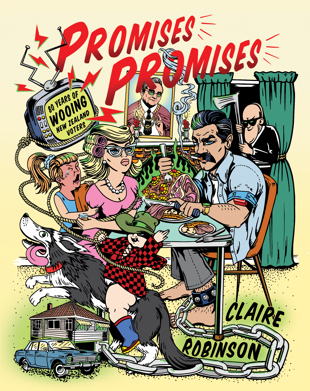Q1: There’s so much amazing visual material in this book. How did you amass it all?
It wasn’t easy! Collecting, preserving, cataloguing and digitising historical visual material has not been a priority for our national collections, and so I had to source the ads from a wide variety of repositories. I have a substantial personal collection of print and television ads that I have collected since I started my PhD in 1999. I sourced a few early booklets and brochures from Les Cleveland’s archive held at the J.C. Beaglehole Room at the VUW Library. The Ephemera collection at the Alexander Turnbull Library provided a large amount of printed material. I sourced newspaper ads from Papers Past and from microfiche held at the National Library. I scoured the Ngā Taonga collection for television ads from the 70s and 80s, and sourced some from the University of Auckland Library. A friend who ran a number of Labour’s advertising campaigns provided me with some print ads, and other television and video ads were sourced directly from political party Facebook pages and YouTube channels.
Q2: The very early advertisements were remarkably text-dense but modern political ads aren’t much more than an image and a slogan. What does this say about us?
Today’s parties are nervous about making too many commitments before elections in case they can’t deliver on them, and so contemporary ads tend to offer images and slogans that convey trustworthiness and credibility only; big on aspiration, short on detail. This isn’t particularly helpful to voters who want more information to help them make choices between alternatives. Having said that, voters are also bombarded with all sorts of political information these days — from Facebook posts to tweets to news stories — and don’t necessarily have the time to read vast screeds of policy promises either. That’s where websites come in handy. If someone wants to know more detail these days, they can find it by visiting party websites.
Q3: It’s interesting to see a couple of Communist Party ads. That would be almost unthinkable today wouldn’t it?
During the 1940s and 1950s the New Zealand Communist Party was painted by both National and Labour as a menace, and tarred with association with the international communist movements in Eastern Europe, Cuba and China, which were regarded as a major strategic threat to the west. I love the way these ads show that their electoral interests in New Zealand were more benign. I particularly like the poster that asks for more community centres, playing fields and improved parking facilities — hardly revolutionary!
The interesting thing is that though the New Zealand Communist party is no longer in existence, and communism as a ‘threat’ has long disappeared, many of the issues the party was concerned about — for example, the power of big international corporations over our lives — are still contemporary concerns that mainstream political parties have taken on. Over the past ten years New Zealand First and Labour have both campaigned on the Communist Party’s earlier concerns over foreign ownership of assets and housing.
Q4: Is there one particular advertisement that you are especially struck by?
Obviously I like them all, which is why I selected them for the book, and I don’t have one favourite over the rest. But I’m especially struck by the print brochures, booklets and posters from the 1940s and 1950s. At a time when modernist New Zealand art and literature, as well as the domestic tourist industry, was searching for a unique ‘New Zealand’ voice and presence, these ads are the complete opposite. They are so Americanised, you’d be hard pressed to identify them as coming from New Zealand.
Q5: What’s the weirdest?
There’s a lot of weirdness in this book. I particularly like a National print ad from 1963 that tries to appeal to young voters by showing National’s hipster side. At the top it reads ‘to be read by young people only’, and the headline copy reads ‘Get With It’, under the image of four young white swinging dancers. The body copy is a forced attempt to sound beatnik. It promises ‘a Government that’s putting New Zealand into the space age with satellite and nuclear research and all that scientific jazz’, adding up to ‘new opportunities with a capital O’. For all its wonderful stereotypes, it’s dreadfully uncool.
Q6: And the most alarming?
New Zealand’s racist underbelly is a theme running through the ads in the book; from the exclusion of images of Māori voters in mainstream ads to the stereotyping of their political worth as factory workers and perpetrators of crime. For me this is exemplified in an alarming 1999 United Future print ad in which the headline asks who voters want to keep the next government on track. Through a portrait image of leader Peter Dunne the ad positions him as the ‘little guy’ that will keep the ‘big guys’ honest, and a row of Māori minor party leader portraits — Winston Peters, Alamein Kopu and Tau Henare — as examples of the ‘wrong little guy’. The ad doesn’t need words to say that right is white, and wrong is Māori. This is one of the powers political ads have; the ability to say things that words cannot or dare not express.
Q7: You make the point at various stages of the book that over the course of 80 years the advertising shows that there is really very little difference between the levers the two main parties have used to woo our votes. Does this mean you are cynical about our political system?
I’m not cynical about the system per se. But I’m disappointed that the exigencies of three-yearly competitive elections mean that our major political parties have resorted to competing over a small range of issues each election, and that the habitual tendencies of voters mean that we take those issues for granted without questioning whether they are the most important problems and solutions of the day, and which groups continue to benefit.
Q8: What do you hope the reader will take away from reading this book?
I hope readers will enjoy my novel take on New Zealand’s political and pictorial history. I also hope they start to question their blind allegiance to the political parties they habitually vote for. For 80 years New Zealand voters have been persuaded to believe that the goals of progress, prosperity and productivity will benefit everyone, everywhere. But history shows that they haven’t delivered, and still aren’t delivering, regardless of which major party is in government. If the book can generate some interesting conversations about alternative visions, I would be happy.
Q9: What’s one new thing you learnt while working on it?
The extent to which our political parties have, over the past fifty years, constructed the ‘war on crime’ simply for political gain. Their ads have created a culture of fear, positioned vulnerable Pākehā women as victims and Māori men as perpetrators of crime, and this has generated an electoral bidding war over police numbers. This in turn has contributed to the high levels of Māori incarceration in prisons, which we know has had a devastating impact on the lives of many Māori families. That they have been collateral damage in political parties’ quest to gain and maintain political power is utterly shameful.
Q10: What’s on your own reading pile at the moment?
Crime writer Karin Slaughter’s Genesis, Marilyn Waring’s The Political Years, Rachel Kadish’s The Weight of Ink and Amy Tan’s Where the Past Begins.


